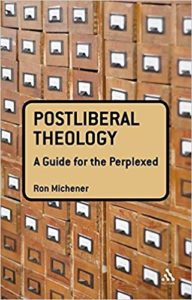
Postliberal Theology: A Guide for the Perplexed

Postliberal Theology and the Church Catholic: Conversations with George Lindbeck, David Burrell, and Stanley Hauerwas
Reviewed by Jacob Goodson, Philosophy, Southwestern College
Recently, an undergraduate student attended my office hours with a list of questions that demanded answers. One of these questions was simple, yet significant. She asked, “What does postliberalism and postliberal theology mean?” She added, without hesitation, “Wikipedia doesn’t give a clear or helpful answer. So what is it?” While I have not read Wikipedia’s description of postliberal theology and, therefore, cannot make a judgment on its clarity or guidance, I will say that Postliberal Theology and the Church Catholic (edited by John Wright) and Postliberal Theology: A Guide for the Perplexed (penned by Ronald Michener) provide clear and helpful answers to the question, “what is postliberalism?”
Postliberal Theology and the Church Catholic reads like an academic drama involving three characters and one narrator. As the editor, John Wright functions as the narrator who sets the stage and offers insightful conclusions. As the three characters or players, David Burrell, Stanley Hauerwas, and George Lindbeck perform both monological material and interactive trialogues with Wright asking them leading and provocative questions. To employ biblical language, I offer (a) judgments on three fruits of this academic drama and (b) three thorns that I found within the contours of the arguments.
The first fruit concerns the wisdom found in the words of Burrell, Hauerwas, and Lindbeck. An example is found in all three players. In his monologue, George Lindbeck reflects on what it means to be an author whose book becomes interpreted in so many different ways that it no longer is “your own work” (71). David Burrell, in his monologue, distinguishes between those students who need certitude and those who seek understanding. The significant word here is “and.” Instead of saying students who need certitude versus those who seek understanding, Burrell wants us to consider how the professorial task is not to transform one kind of student into the other but, rather, learn how to teach to both types of students. The verbs are significant too. Those who “need certitude” tend to need it and not seek it. While those who seek understanding tend not to need as much certitude as the first type of student but remain more comfortable in the search (see 79-80).
Within the conversation between the three, Stanley Hauerwas diverges from the optimism of Burrell and Lindbeck on the contemporary church and takes their discussion on ecclesiology in a different direction. Hauerwas claims that marketing shapes ecclesial differences more than real theological disagreements (see 128-129). I believe that this wisdom from Hauerwas comes from the continual criticism that he receives about his work; his critics often ask, “Where is this Church that you describe as a peaceable community of character that is formed around the liturgy and theological conviction?” In a sense, Hauerwas turns this question to Burrell’s and Lindbeck’s musings on the theological differences between denominational churches within Europe and the United States. With a prudent touch of realism, Hauerwas responds to Burrell and Lindbeck that what they credit with theological depth should be described as business-like strategies and marketing schemes. In other words, Hauerwas sounds like a Niebuhrian realist here: manipulation and power determine ecclesial differences, not scriptural interpretation and theological doctrines! With my experience serving on Church Council in a very serious and theologically minded Lutheran congregation, I find that Hauerwas’ comment is descriptively right. However, neither of us would affirm that it is normatively correct but a fact to be lamented – not celebrated.
Before moving on to the second fruit, it is important to reflect on the wisdom offered. Lindbeck gives us words of wisdom on scholarship and writing: when we write, it becomes possible for our writing to be no longer “ours.” What our words mean become dependent on how they are interpreted, and sometimes our words take on a life of their own beyond our control. As Lindbeck admits, sometimes we come to understand our words as contradictory and messy:
I talk about how Christian theology must not be built on foundations other than biblical foundations. To use the expression I used, the biblical world should absorb the world, rather than be founded on nonbiblical, intellectual views. I contradict myself, in a way [when I wrote about Clifford Geertz’s anthropological methodology]. That is the major problem with the book [The Nature of Doctrine]. (71)
While Lindbeck gives us words of wisdom on the task of writing, Burrell offers words of wisdom on teaching: when we teach, we should resist the tendency to speak to all students as if they have the same expectations and needs. Some “need certitude” whereas other students remain more comfortable with the search for understanding. Lastly, Hauerwas’ provides us words of wisdom in relation to the local congregation: theologians should not deceive themselves into thinking that theology matters more than marketing for making sense of ecclesial differences within contemporary society.
The second fruit of the academic drama comes in the connections explained and explored between Burrell’s inter-Abrahamic investigations, the logic of Hauerwas’ Church-world distinction, and Lindbeck’s Catholic-Lutheran ecumenical endeavors. The narrator, John Wright, emphasizes how this represents “postliberalism” in three different arenas – which means that postliberal theology is neither flat nor static but, rather, moves in and out of different academic questions and ecclesial problems.
The third fruit of the academic drama involves John Wright’s corrective response to Paul DeHart’s criticism of postliberalism. In The Trial of the Witnesses: The Rise and Decline of Postliberal Theology, DeHart puts Lindbeck’s work on “trial” where “a public of some sort” renders a judgment for or against “theological proposals” (143). DeHart makes the judgment that this public, which remains undefined, makes the judgment that Lindbeck’s postliberalism fails. Wright takes DeHart’s criticisms head on and raises questions about the vagueness of this “public.” Wright identifies which public makes judgments on theological proposals: the public comprised of “the communion of saints.” Wright writes: “The jury of the communion of saints, particularly those exemplary among them, will not countenance any sectarian collapse inward for the purity of the church’s identity contrasted against its mission” (147). The reason this is a fruit of the book is, whether one sides with DeHart’s critique of Lindbeck or not, from a logical perspective Wright pushes hard on the vagueness of DeHart’s notion of “public.”
I also find three thorns with Postliberal Theology and the Church Catholic. First, Wright offers a thin notion of experimentalism. According to Wright, the first generation of postliberal theologians were committed to their own “experiments” – all of which went against the grain of the academy as they found it. Lindbeck’s “experiment” involves ecumenism in general and Lutheran-Catholic relationships in particular. Hauerwas’ “experiment” includes attention to the differences that Jesus Christ makes for inter-human relationships, and the experimentalist aspect of Hauerwas’ teases out – in every possible way – the legitimacy of the distinction between the Church and the world. Burrell’s “experiment” concerns how following Thomas Aquinas’ lead in maintaining deep relationships with Jewish and Muslim theology works within the contemporary academy. However, Wright does not present their experimentalism in any logical detailed ways. He uses the word without explaining its complexity and significance, especially in terms of the intricacies of how the “results” of experiments work.
In contrast, the American philosopher Charles Sanders Peirce highlights the complexity and significance of experimentalism by outlining the differences between induction, deduction, and abduction. According to Peirce, true experimental thinking works mostly through abduction; the mistake of modern philosophy is to reduce experimentalism either to induction (modern empiricism) or deduction (Cartesianism). Abduction names “the process of forming explanatory hypotheses. It is the only logical operation which introduces any new idea.”1 Abduction incorporates every operation that devises and introduces arguments, conceptions, and theories. Experiments work by following abductions, how old ideas form “new ideas” without these new ideas becoming their own static principles and propositions – which is precisely what Wright claims about how postliberal theologians work: they form “new ideas” in relation to the old arguments found within the academy and the Church.
Peirce’s notion of experimentalism can be explained through the language of the courtroom. For instance, Peirce uses the word “verdict” to describe how we make judgments on our working experiments.2 The verdict, itself, becomes reliant on the quantity and quality of the working principles and propositions; these principles and propositions can and should be changed through the testing process.3 Peirce calls this process “infinite,” meaning that it should seem never-ending to the current practitioner of the experiment – which is also why Peirce, himself, talks about the necessity for a community of inquiry. This community of inquiry serves as the judge and jury of the results put forth from different and various experiments. At this point, I want to suggest that Wright’s argument that the communion of saints is the “public” that tests the claims of postliberal theology and that the communion of saints serves as the “jury” for postliberal theologians has very strong backing in the experimental philosophy of Peirce. However, Wright’s connections between legal trials, experimentalism, and the communion of saints remains uninterestingly thin in relation to the ways in which Peirce worked out these notions over a hundred years ago. Peter Ochs’ work, which brings Peirce’s philosophy to bear on the work of postliberal theologians, provides a tremendous amount of clarity and helpfulness to the exact issues introduced by Wright.4 The point concerning Peirce’s in-depth exploration of experimentalism reveals a weakness with Wright’s story. Wright seeks breadth yet avoids depth.
The second thorn is when Wright connects the work of Hans Urs von Balthasar, Yves Congar, and Henri de Lubac with that of David Burrell, Stanley Hauerwas, and George Lindbeck. It does not push the conversation along in fruitful ways. Instead, it makes the reader feel like they have to chase rabbits without knowing what it is we catch when we find the animal. Wright’s connections remain suggestive and vague, and – in terms of the theological drama mentioned earlier – it entails mere gesturing rather than developing a thicker plot.
My final point in regards to Postliberal Theology and the Church Catholic is that the third thorn is found in Wright’s conclusion. The inclusion of Dietrich Bonhoeffer at the very end of the book weakens the distinctiveness of the postliberal theology claimed and described throughout the book. Bringing in Balthasar, Congar, de Lubac, and now Bonhoeffer are not bad moves but, ultimately, unproductive ones. Postliberal Theology and the Church Catholic consistently addresses and details the distinctive nature of postliberal theology, and these attempts at “reaching out” – for purposes of breadth – provide an implicit challenge to those claims of distinctiveness.
Ronald T. Michener also tends toward breadth in his Postliberal Theology: A Guide for the Perplexed. The biggest difference between Michener’s and Wright’s account of postliberalism are the cast members. Wright’s narrative features the thoughts of Burrell, Hauerwas, and Lindbeck while Michener features Hans Frei, instead of David Burrell, as well as Stanley Hauerwas’ and George Lindbeck’s work. Nevertheless, the contribution that this book makes to scholarship on postliberal theology is found in its presentation and summaries of younger theologians and philosophers whose work adds to the movement of postliberal theology: namely Kathryn Tanner and James K. A. Smith.
Kathryn Tanner supplies a “postliberal” logic of diversity, as well as reflections on the relation between diversity and unity. Michener writes, “Kathryn Tanner … strongly emphasizes diversity with unity in her vision of postliberal theology. With Tanner, unity comes not through exactness of beliefs and practices, but on a common commitment to pursue Christian practices of discipleship from the life of Jesus” (90). The consequence of Tanner’s postliberal logic for diversity is a pill that might be difficult for theologians to swallow: “For Tanner … rather than dismissing those with whom we disagree as being uninformed or improperly trained, it is more charitable to come to grips with the fact that even Christians trained in the ‘rules’ do not necessarily come to complete agreement” (92). What Tanner adds to postliberal theology is a logic of diversity, in unity, that simultaneously builds upon and challenges tendencies within postliberalism.
James K. A. Smith adds an emphasis on “head and heart” to postliberal theology (see 122-127). According to Michener, postliberal theology’s battles with the modern academy led them to thinking and writing in terms concerning only matters of the “head.” Smith not only brings new energies to postliberal tendencies but also articulates a philosophical perspective on why “an incarnational anthropology” requires paying attention to the “affective aspects” of humanity. Postliberal theologians tend to shy away from the affective aspects because of Lindbeck’s criticisms of “experiential-expressivism,” but Smith’s work provides an account of affectivity without falling back into the problems of “experiential-expressivism.” In short: Tanner’s theological writings add an account of diversity to postliberal theology, and Smith’s philosophical perspective adds a non-problematic account of the affections of “the heart” to the postliberal tendency to emphasize “the head.”
Part of the postliberal project involves demonstrating how Christian theologians cannot continue to forget their relationship with ancient Israel and with Judaism. One of the problems with Michener’s “guide” through postliberal theology is that he excludes a serious discussion on Judaism. Regrettably, he writes:
Although we [who is this “we”?] agree that [Peter] Ochs’ influence on the broader scholarship of this movement is arguably significant, we have chosen not to include his work in the discussion due to … our primary focus on postliberal theology in the context of the particularity of the Christian narrative. (15)
In order to clarify this last phrase, I should add: “the particularity of the Christian narrative [independent of Judaism].” This signifies that Michener has missed the point of Christian postliberal theology. Its primary corrective in the Church and in the modern academy is to show how “the particularity of the Christian narrative” cannot be narrated and understood independently from ancient Israel and rabbinic Judaism.
To summarize: Wright’s narrative bears tons of fruit, but the lack of depth concerning the notion of experimentalism leaves readers wanting more. Ochs’ diagrams on how Peirce’s philosophy helps us make sense of the logic of postliberal theology should come into play within Wright’s book. Michener’s “guide” helpfully introduces how the work of younger philosophers and theologians relates to the concerns of Frei, Hauerwas, and Lindbeck; however, Michener misses the importance of the postliberal repair of addressing the particularity of the Christian narrative independent of its necessary relationship with Judaism. While I hope to conclude on a positive note in the next paragraph, I also want to point out that Michener’s neglect of Judaism commits some of the same “sins” that he points out with the “conservative Biblicists” in the quotation given below. To abstract the Christian narrative from its Jewish context, and its continued relation with Judaism, is to assume that the “Bible has become a collection of little snippet vitamins or propositional energy bars by which to feed the soul with daily nourishment” (124).
So, we return to the question, what is postliberalism and postliberal theology? Perhaps the clearest answer we have to my student’s question comes toward the end of Michener’s Postliberal Theology: A Guide for the Perplexed:
Many conservative Biblicists … have taken a ‘vitamin’ approach to scripture. The Bible has become a collection of little snippet vitamins or propositional energy bars by which to feed the soul with daily nourishment. Your spirituality of the day is determined by whether or not you have moved your eyes over a page or a passage of the Bible. Once this happens, you are ready to begin your day. Other liberal approaches may not care as much about reading the Bible, as much as they care about applying the existential lessons encased in the heart of the biblical stories. Both approaches tend to separate the head from the heart … and they neglect a full-orbed view of biblical anthropology, hence neglecting the reality and truth of the biblical narrative. The biblical narrative has value in and of itself; it may not be flattened out as a mere device to produce a faith lesson for our existence (liberal) or faith application and defence from its history (conservative). It is story, and must be embraced as our story as we are the people of God through whom [God’s] ongoing story is told. (124)
Postliberal theology names the tendencies (a) to emphasize the significance of biblical narratives on their own terms, (b) to heal unnecessary divisions found within biblical scholarship (Hans Frei), within ecumenical conversations (George Lindbeck), and within interfaith theological investigations (David Burrell), and (c) to integrate “head and heart” in the academy and the Church. Both Michener’s and Wright’s books successfully “guide” us in how these tendencies manifest themselves in the work of postliberal philosophers and theologians.
Cite this article
Footnotes
- Charles Sanders Peirce, The Collected Papers of Charles Sanders Peirce, vol. 5 (Cambridge, MA: Harvard University Press, 1935), 172.
- Ibid., 399-413.
- “These controversies do get settled, after a time, in the minds of candid inquirers; though it does not always happen that the protagonists themselves are able to assent to the justice of the decision. Nor is the general verdict always logical or just” (Ibid., 401).
- See Peter Ochs, Peirce, Pragmatism, and the Logic of Scripture (New York: Cambridge University Press, 1998); and Peter Ochs, Another Reformation: Postliberal Theology and the Jews (Grand Rapids, MI: Baker Academic, 2011).























